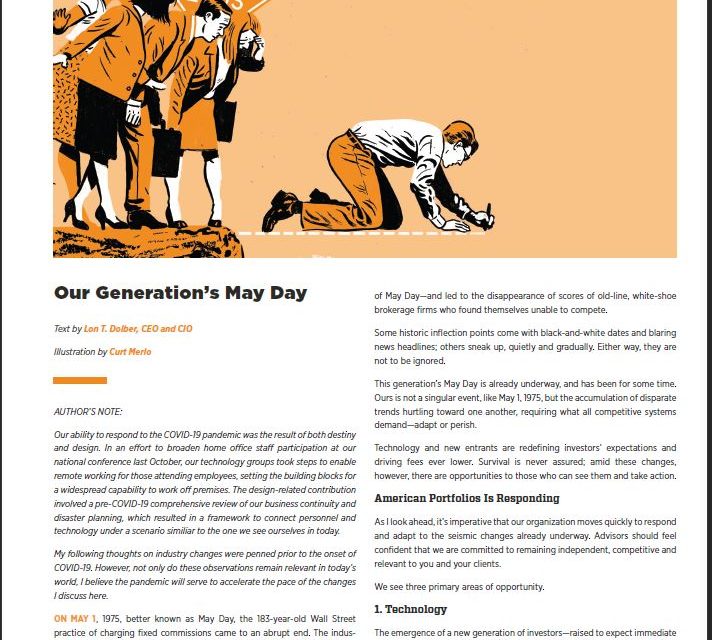
Our Generation’s May Day
On May Day, the 183-year-old Wall Street practice of charging fixed commissions came to an abrupt end. The industry profoundly and irreversibly changed that day. It gave rise to discount brokers—Charles Schwab being the pioneer and most successful offspring of May Day—and led to the disappearance of scores of old-line, white-shoe brokerage firms who found themselves unable to compete. Some historic inflection points come with black-and-white dates and blaring news headlines; others sneak up, quietly and gradually. Either way, they are not to be ignored.
To view the full article please register below:
Our Generation’s May Day
ON MAY 1, 1975, better known as May Day, the 183-year-old Wall Street practice of charging fixed commissions came to an abrupt end. The industry profoundly and irreversibly changed that day. It gave rise to discount brokers—Charles Schwab being the pioneer and most successful offspring of May Day—and led to the disappearance of scores of old-line, white-shoe brokerage firms who found themselves unable to compete. Some historic inflection points come with black-and-white dates and blaring news headlines; others sneak up, quietly and gradually. Either way, they are not to be ignored.
This generation’s May Day is already underway, and has been for some time. Ours is not a singular event, like May 1, 1975, but the accumulation of disparate trends hurtling toward one another, requiring what all competitive systems demand—adapt or perish.
Technology and new entrants are redefining investors’ expectations and driving fees ever lower. Survival is never assured; amid these changes, however, there are opportunities to those who can see them and take action.
American Portfolios Is Responding
As I look ahead, it’s imperative that our organization moves quickly to respond and adapt to the seismic changes already underway. Advisors should feel confident that we are committed to remaining independent, competitive and relevant to you and your clients.
We see three primary areas of opportunity.
1. Technology
The emergence of a new generation of investors—raised to expect immediate access and self-service transaction capabilities—demands much more than what current technology platforms deliver. The days of the advisor or sales assistant acting as the nexus between a client request and service execution is disappearing quickly.
This means that our technology must become highly intuitive to the advisor and client, alike. Above all, it must begin involving the end client—the investor. Better technology, though, isn’t just about ensuring future relevance for a new wave of asset accumulators; it will be the tool that enables advisors to achieve the scale necessary to survive further fee compression.
With our new BlueDock platform (see pg. 20), advisors can enable prospects and clients to navigate their financial future through a number of self-service, broad-based financial tools, while simultaneously allowing advisors to streamline practice management and back office functions. I believe BlueDock will be a cornerstone to successfully meet the challenges presented by the disruption we see in our business today.
2. Reimagining Revenue Opportunities
The predominant source of an advisor’s revenues is either the commissions or fees associated with their role as a registered representative or investment advisor representative. Other services, such as financial planning, are typically provided as a free, value-added benefit of working with the advisor.
As downward pressure is exerted on advisory fees, advisors will need to find new revenue opportunities. Ours is not the first industry to confront this challenge. For instance, the prime source of revenue for dentists was always periodic check-ups and filling cavities. As oral hygiene became more effective, dentists had to look for new ways to earn money, which they found with whitening and clear-aligner teeth straightening for adults.
Dentists provide a model for how advisors can seek to establish additional verticals to generate new sources of revenue. For advisors to implement new fee-generating verticals, they will need a platform to enable it.
Through our Advice Pay technology, advisors will have an ideal tool to bill for services, such as employee benefits reviews or social security planning, making their new fee-for-service initiatives simple, seamless and profitable. Advice Pay is currently in beta testing and should be available later in 2020.
3. Fee Compression
The announcement of zero commissions last fall by the big online brokerages was not an exclamation point signaling the climax of a grand trend. Rather, it was the shot of a starter gun to begin a very long race. That race may be one to the bottom. Expect in the not-too-distant future that brokerages will begin paying investors to put their assets with them. After all, many brokers have already become de facto deposit institutions, making the bulk of their profits on the cash held with them.
There is no silver bullet to solving this fee compression challenge. It will need to be attacked on three fronts: technology, service and economics. On the technology front, our mission is to make our platform easy to use and a tool that can help advisors become more efficient to better scale their practices.
With regard to service, moving clients toward e-delivery and greater self-service will help reduce expenses, even as it improves servicing. However, the support of our advisors in migrating clients to self-service will be instrumental to its success.
As it relates to economics, we have renegotiated and restructured the services contract with Pershing, converting to an asset-based payment schedule; doing so effectively removes Pershing as the middleman in determining pricing and empowers us to assess fees that we and our advisors believe will help us to become more responsive to changes in our industry. As you’ve already seen some pricing modifications in effect the beginning of April rewarding accountholders with zero confirm and statement fees for choosing to go paperless, we anticipate rolling out other changes in the future. There was a time that the genius and will of one person—Thomas Edison, Nikola Tesla, Robert Noyce—could single-handedly change the world. That world no longer exists. Today, innovation and change occur through the collaborative efforts of many. If American Portfolios (AP) is to successfully adapt to this new era, it will only happen through the collective efforts of the AP team and its advisor partners.
I encourage all our investment professionals to join us in charting our future and maintaining the cherished independence that has been the foundation of our mutual success.
AUTHOR’S NOTE: Our ability to respond to the COVID-19 pandemic was the result of both destiny and design. In an effort to broaden home office staff participation at our national conference last October, our technology groups took steps to enable remote working for those attending employees, setting the building blocks for a widespread capability to work off premises. The design-related contribution involved a pre-COVID-19 comprehensive review of our business continuity and disaster planning, which resulted in a framework to connect personnel and technology under a scenario similiar to the one we see ourselves in today. My following thoughts on industry changes were penned prior to the onset of COVID-19. However, not only do these observations remain relevant in today’s world, I believe the pandemic will serve to accelerate the pace of the changes I discuss here.
Please reference disclosures: https://blog-dev.americanportfolios.com/disclosures/












